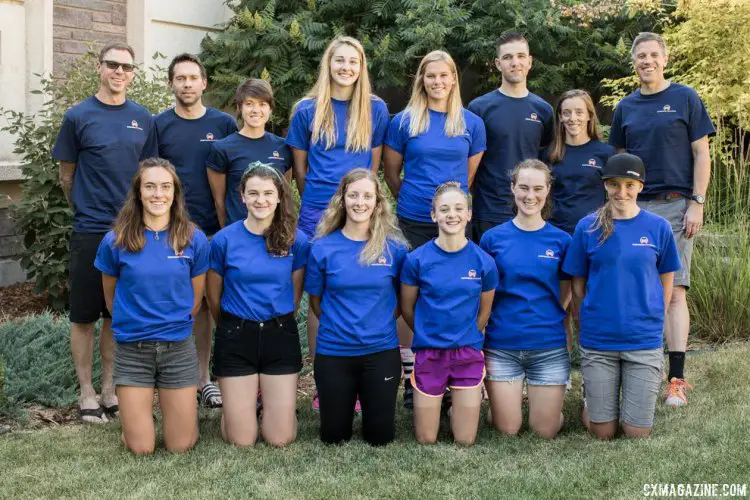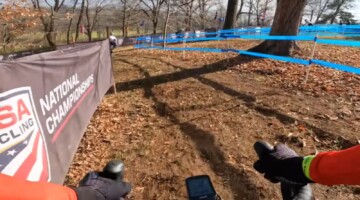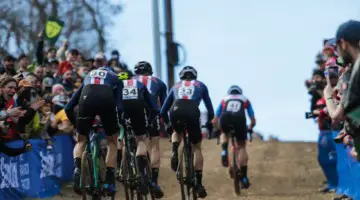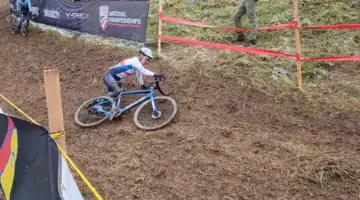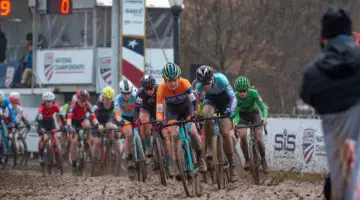During the past few months, we have gotten to learn a lot about Geoff Proctor through the thoughts of the young men who attended the 2017 MontanaCrossCamp in July. They described a man of passion and focus who always has his eye set on helping the future stars of U.S. cyclocross improve.
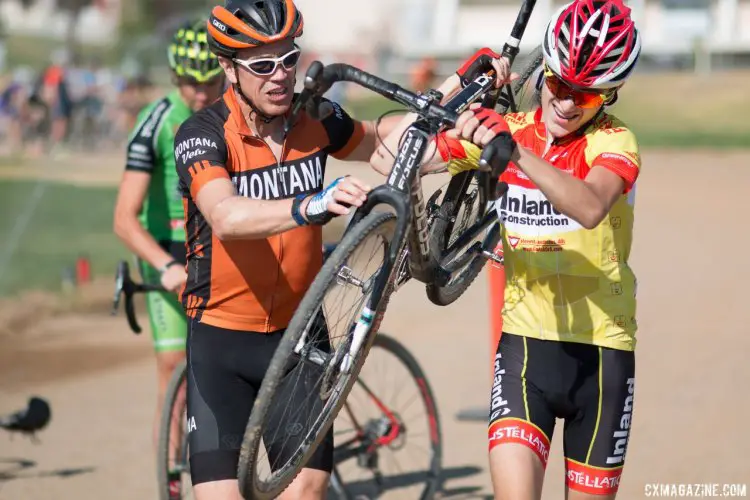
Geoff Proctor has campers ready for anything, including the rare-but-useful shoulder bike exchange. 2017 Montana Cross Camp © Cyclocross Magazine
We have also gotten the opportunity to learn about Proctor’s cyclocross training regimen that draws drills from several different sporting backgrounds. Cyclocross Magazine‘s Andrew Yee did two in-depth Training Tuesday posts that provided an inside look at Proctor’s off-the-bike training drills which, if you have followed our interviews, you know include plenty of running, as well as his on-the-bike skills exercises.
In addition to his MontanaCrossCamp, Proctor has been coordinating the European racing blocks for young U.S. riders for over a decade. He is currently busy planning the November Euro block that will send ten riders to the Bogense, Denmark and Zeven, Germany World Cups.
Proctor was recently selected as USA Cycling’s Cyclocross Performance Consultant, which is a step toward having a full-time program director similar to other disciplines. The new position will give him an even bigger opportunity to bring his vast experience to the development of young cyclocross talent in the U.S.
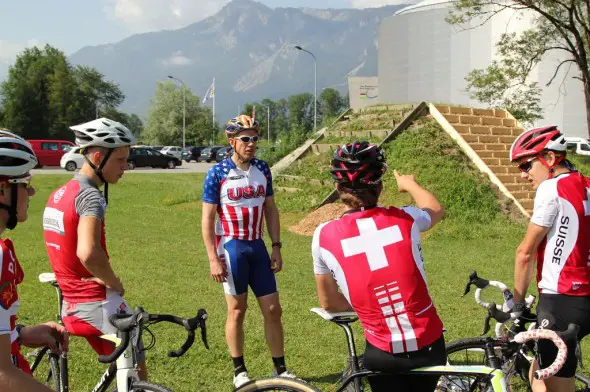
Geoff Proctor, seen here in 2012, has represented U.S. cyclocross development both at home and abroad for years. photo: Keith Flory
Cyclocross Magazine wanted to learn more about Proctor’s new position and hear his thoughts on the state of cyclocross development in the U.S, and of course, ask him what it is like to have his young campers say so many nice things about him. We chatted with the Montana resident as he prepares to send riders to Europe for the November Euro block.
Interview with Geoff Proctor, USAC Cyclocross Performance Consultant
CXM: What’s your new role with USA Cycling?
Geoff Proctor: Over the summer, I accepted the position of Cyclocross Performance Consultant. As part of USA Cycling’s reorganization of the Athletics Department, I am now beginning to coordinate support for some of our medal-potential riders as well as running USAC’s Cyclocross program.
CXM: Why does cyclocross get a consultant while other disciplines get a director?
GP: The title essentially has to do with working part time versus full time. Given the timing of this new position, I’m still full-on teaching, but USAC’s High Performance Plan calls for a full-time Cyclocross Program Director, so that is my goal over the next year.
It’s also part of an exciting upcoming reform where top athletes across different disciplines will earn national team status based on their results. I’ve just returned from a USAC Coaches’ Summit where USAC personnel from every capacity—coaches, directors, operations managers, tech, CEO Derek Bouchard-Hall—all came together as key leaders directing our progress going forward. It was pretty special for me as I’ve been going at this for a long time.
CXM: How does the new role mesh with your jobs as a teacher and camp director?
GP: It’s meshing pretty well. Marc Gullickson is now the full-time Mountain Bike Director and I’m doing the same position for cyclocross. I’m managing operations for our World Cup teams and our European blocks for our development riders, and I will lead the team during the December and World Championship blocks.
Naturally, there are some challenges, in terms of time and budget, but we’re managing. As always—and this is going on 15 years for me—I’m motivated to see what our riders can do in the upcoming European blocks and at the World Championships. We have ten riders for the November Euro Block and about the same number for December.
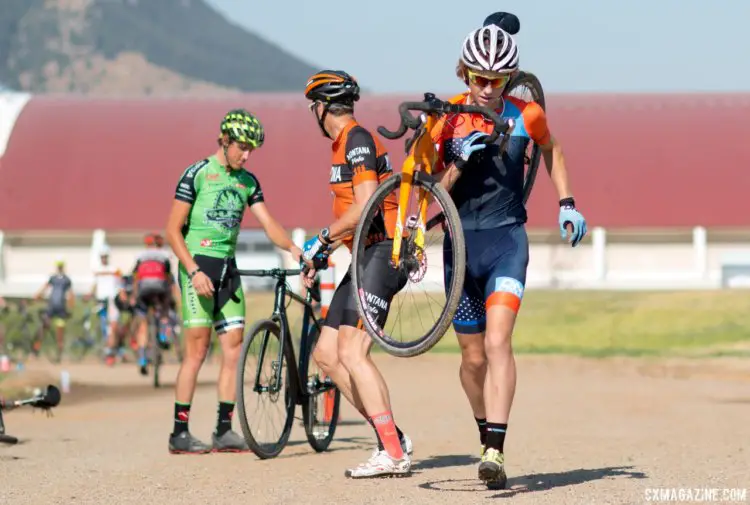
Proctor takes a hands-on approach to working with young riders. 2017 Montana Cross Camp © Cyclocross Magazine
CXM: What are the first changes you hope to put in place?
GP: Some changes have been in the works for awhile. I’m really excited about the idea of supporting individual athletes and coordinating resources for them across disciplines. Jim Miller, Vice President of High Performance, has done the lion’s share of creating the vision here and I think it can lead to achievement on a level we haven’t seen yet. The new national team concept is part of this as well.
In terms of cyclocross-specific changes, I am full of ideas about where we can improve. Things will take some time, but I think we can really get there in this new chapter. I want to work on bridging club cultivation with the national team pathway, building a progression for our camps, clinics and races and creating more opportunities for our young riders, both here and in Europe.
I also really want to work together with our USA Cycling Cyclocross Sports Committee. This group—Brook Watts, Pete Webber, Adam Myerson, Stu Thorne, Charles Townsend, Tom Mains, Tom Nee, Jeremy Powers along with USAC’s Chuck Hodge and Joan Hanscom, I hope I’m not forgetting anyone—is composed of really good minds critical to moving things forward.
CXM: The role seems oriented at raising our top talent to the highest level, but to keep that talent pool healthy it would seem like it would be in USA Cycling’s best interest to also pour a lot more people into the funnel by introducing them into the sport. What responsibilities or influence in this area will you have? Ideally, should we also have growth directors or consultants?
GP: In all of my work from the early days of EuroCrossCamp back in 2003 to MontanaCrossCamp, I’ve tried to focus on developing current talent as well as discerning and nurturing the younger age groups. No question we need to broaden the funnel. We haven’t yet scratched the surface.
The first steps are to get those who really care about development together and make a plan to go forward. Our clubs and teams are providing a lot of excellent development. I really appreciate that foundation when I work with young riders.
CXM: What is your role in picking World Cup and Worlds participants? Is that process set in stone for this season, or might you make changes to it?
GP: The selections for World Cups and World Championships are all laid out in different USAC documents. These policies have not changed very much in recent years. World Cup selection is closely aligned with UCI rankings, and Worlds selection is based on a number of criteria. Eventually, right around the new year, all of the information is put together by USAC’s Scott Schnitzspahn, Vice President of Elite Athletics, and presented to the Selection Committee. And then we go forward with our Worlds team.
The biggest challenge is finding the resources for these trips. I’m dedicated to finding ways to support riders who earn these selections. One recent bright moment is the USAC Cyclocross program recently received a generous donor grant of $10,000, matched by $5,000 from the USA Cycling Foundation. This will be put directly towards funding the December Block of European racing. Contributions like this can make a huge difference to the success of the program. Cultivating the next generation of strong American riders is paramount.
CXM: USA Cycling used to help fund your MontanaCrossCamp. What impact will your role have on whether that remains an independent event, or becomes a partnership again? Might you secure funding for it again?
GP: This is ongoing. For the first five years, the Montana summer camp was funded in part by USA Cycling. The past two summers, it’s been private as MontanaCrossCamp. I’d very much like to have it become part of the USAC pathway again, as long as I can support the athletes and my staff on the same level.
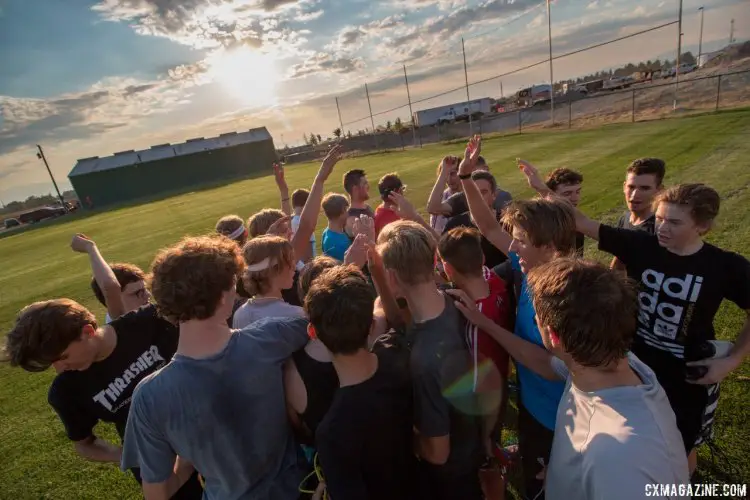
Proctor’s camp has brought young U.S. cyclocross talent to Montana for years now. 2017 Montana Cross Camp © Cyclocross Magazine
CXM: How will you avoid a bias towards camp attendees when it comes to rider selection for big events?
GP: As I mentioned above, the selection of Elite riders for World Cups is strictly based on UCI ranking. In the development levels, there is some discretionary selection, but my approach is the same—try to select the best riders based on their UCI ranking, their results and what works for them with school, finances and other things.
CXM: You’ve seen our one-on-one camp interviews trickle out. We’ve asked most of the campers their opinions on the camp experience as well as their impressions of you. What’s your reaction to watching these?
GP: Your interviews with all these young riders have been fun to watch. To think back to this summer and how much work we put in, how much fun we had, how much they’re growing as riders and now seeing them perform at these selection races like Cincy and Pan-Ams, I hope we can do something like this again in the future.
Having Andrew Yee come to Montana was something I’ve wanted to achieve for a long time, but I’d tweak it next time. First, I want our women’s camp to get the same opportunities, so hopefully Cyclocross Magazine doesn’t have schedule conflicts again! This past summer was our first women’s camp and it was super. So great.
And second, I want Andrew to ask the riders about the other coaches, rather than me. This year’s coaches—Kaitie Keough, Allison Arensman, Chris McGovern, Tobin Ortenblad, Scott Herzig, our U23 riders Gage Hecht and Lance Haidet—are top-shelf and I think that would be reflected in rider responses.
At our recent USAC Coaches Summit, we were asked why we do what we do. My response was that I view investment in young people to be my life’s work. I can’t imagine doing anything else. It’s the single best way I know to give back, to shape the world with one’s small contribution. It’s similar to being a parent in that you invest in your kids with what is important to you, and ultimately, to them. You don’t see those results for 20-30 years, but you know it’s what you want to do. And while the how and the what might change, the why stays the same.
CXM: Your training approach is unique and could benefit young riders across the country. Have you thought about ways of exposing a broader audience, besides CXM covering it, to your approach?
GP: I would love to get some of our best cyclocross coaches together and build some sort of national curriculum of best practices for training and prepping for cyclocross. Then we can build the pathway and share a set of skills and practices and we continue to build from there. We have an incredible group of strong cyclocross coaches around the country. We absolutely need to tap into this body of knowledge.
Personally, because I’m old, I think naturally my strongest skill is experience, but I’m constantly trying to add new layers to that. For instance, I’m passionate about the nature of competition. I love studying the demands of other sports like soccer, ski racing and tennis and then looking at what is required in cyclocross and then finding ways to train those things. I’m already working on some new material for next summer. I know the campers will love it.
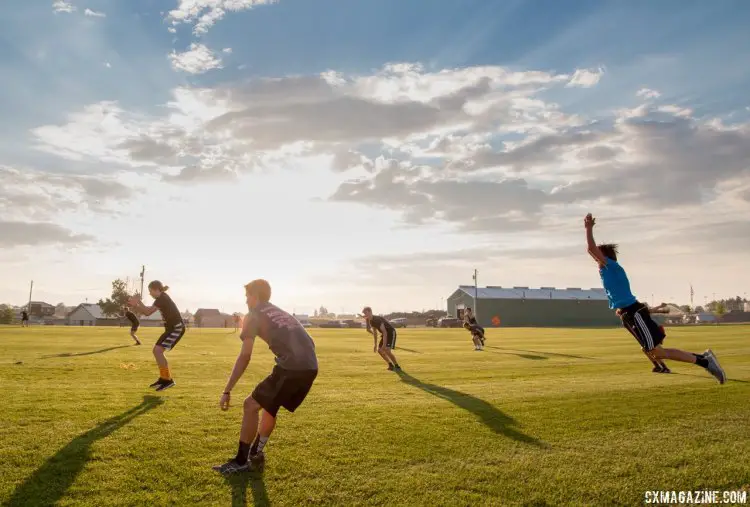
Proctor is always ready to jump at the opportunity to add new skills and drills to add to his cyclocross training program. Morning workout, 2017 Montana Cross Camp © Cyclocross Magazine
CXM: Cyclocross in the Olympics. Yay or nay?
GP: I’ve always been a huge advocate for including cyclocross in the Olympics. During my time on the UCI Cyclocross Commission, we’ve achieved some really significant reforms, but one that continues to elude us is Olympic inclusion. The biggest hurdle seems to continue to be the charter that states winter Olympic sports must be practiced on ice or snow. It’s tough because when you hold dear the vision of development, of broadening the pool, of sharing the beauty and spectacle that is modern cyclocross, you know the best way to achieve that is to gain Olympic recognition.
Not to mention, having cyclocross as an Olympic sport would change budgetary challenges overnight. Imagine for a minute, the second-to-last-day of the two-week Olympic experience when most of the athletes are done and in festive moods. Put the cyclocross circuit in or near the downtown of the winter Olympic host city, near the athletes’ village. Put it under the lights, with the sparkle of a crisp winter evening. It would be absolutely off-the-charts. And it wouldn’t be anything we who love ’cross don’t already know, but we would finally be able to share it with a world audience. It would be a “send it” moment for our discipline!
CXM: That sounds pretty awesome. Thanks for your time and thanks for everything you do for cyclocross here in the U.S.
GP: You’re welcome. Thank you.
For more on Geoff Proctor’s history in the sport of cyclocross, we have an extensive archive covering his work.













